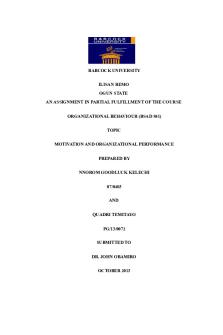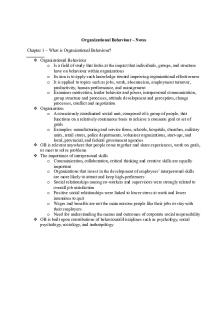Organizational Behaviour MCQ SET PDF

| Title | Organizational Behaviour MCQ SET |
|---|---|
| Author | विनीत पाण्डेय |
| Course | Organizational Behaviour |
| Institution | NIMS University |
| Pages | 20 |
| File Size | 306.8 KB |
| File Type | |
| Total Downloads | 53 |
| Total Views | 152 |
Summary
MCQ...
Description
Organizational Behaviour-I Multiple Choice Questions with Answers SET-A Q1. Organization structure primarily refers to a. how activities are coordinated & controlled b. how resources are allocated c. the location of departments and office space d. the policy statements developed by the firm Q2. The purpose of job enrichment is to a. expand the number of tasks an individual can do b. increase job efficiency c. increase job effectiveness d. increase job satisfaction of middle management Q3. Strategic planning as a broad concept consists of corporate strategy and business strategy a. strategy formulation and strategy implementation b. inputs and outputs c. environmental analysis and internal analysis Q4. According to Herzberg, which of the following is a maintenance factor? a. Salary b. Work itself c. Responsibility d. Recognition
Q5. A major problem with a task force type of management is a. there is no logical basis for task force information b. its status is too inflexible c. accountability d. lack of planning Q6. Individuals such as Albert Einstein, Edwin Land and Steven Jobs lead through which type of power? a. Legitimate b. Reward c. Expert d. Charismatic
1
Q7. Communication begins with a. encoding b. idea origination c. decoding d. channel selection Q8. Functional managers are responsible a. for a single area of activity b. to the upper level of management and staff c. for complex organizational sub-units d. for obtaining copyrights and patents for newly developed processes and equipment
Q9. Policies are sometimes defined as a(n) a. shortcut for thinking b. action plan c. substitute for strategy d. substitute for management authority
Q10. The problem-solving process begins with a. clarification of the situation b. establishment of alternatives c. identification of the di culty d. isolation of the cause Q11. A study of the culture and practises in different societies is called a) Personality b) Anthropology c) Perception d)
Attitudes
Q12.
is known as ffthe father of scientific management.ff
a) Fredrick W. Taylor b) Henry Fayol c) Robert Owen d) None of these
2
Q13.
a young Welsh factory owner was one of the first to emphasise the human
needs of employees: He refused to employ young children a) Andrew Ure b) J.N. Tata c) Robert Owen d) None of these Q14.
embodies a team concept, is based on the principle of mutual contribution by employer
and employees a) Autocratic model b) Custodial model c) Supportive Model d) Collegial Model Q15. Contribution/s of human relations movement is/are a) Great Depression b) Labour Movement c) Hawthorne Studies d) All of these Q16. Edward Tolman is related to a) Behaviourist Framework b) Cognitive approach c) Social Cognitive Framework d) None of these Q17. Forces affecting organisational behaviour are a) People b) Environment c) Technology d) All of the above Q18. Hawthorne Studies is related to which stage of the organisational behaviour evolution a) Industrial revolution b) Scientific management c) Organisational behaviour
3
d) Human relations movement Q19. In present context, challenges for OB are a) Employee expectation b) Workforce diversity c) Globalization d) All of the above Q20. Meso organisation behaviour is related with a) Individual behaviour b) Group behaviour c) Organisational behaviour d) None of these Q21. Leadership motivates the people to work and not the power of money, this concept is related to a) Autocratic model b)Custodial model c) Supportive Model d)Collegial Model
Q22. Organisational behaviour is a field of study backed by a body of associated with growing concern for people at workplace a) Theory b) Research c) Application d) All of the above Q23. Organisational behaviour is a) A science b) An art c) A science as well as an art d) None of the above Q24. The field of organisational behaviour examines such questions as the nature of leadership, effective team development, and a) Interpersonal conflict resolution; motivation of individuals b) Organisational control; conflict management
4
c) Motivation of individuals; planning d) Planning; development Q25. The term ‘psychology’ is derived from the word ‘psyche’, which means ‘soul’ or ‘spirit’ a) Latin b) French c) Greek d) None of these Q26. The field of organisational behaviour is primarily concerned with a) The behaviour of individual and groups. b) How resources are effectively managed. c) Control processes and interactions between organizations, external context. d) Both a and c.
Q27. The study of organisation behaviour has certain basic assumptions. They are a) An industrial enterprise is an organisation of people. b) These people must be motivated to work effectively. c) The goals of the employee and the employer may not necessarily coincide. d) All of the above.
Q28. Which of the following represents correct sequencing of historical developments of Organisational Behaviour? a) Industrial revolution —> Scientific management –> Human relations movement –> OB b) Industrial revolution —> Human relations movement —> Scientific management –> OB c) Scientific management —> Human relations movement –> Industrial revolution –> OB d) None of these.
Q29. Which of the following frameworks is used in the development of the overall model of OB? a) The cognitive framework b) The behaviouristic framework c) The social learning framework d) All of the above
5
Q30. Which of the following frameworks is based on the expectancy, demand and incentive concepts a) The cognitive framework b) The behaviouristic framework c) The social learning framework d) The supportive framework Q31. Which of the following forms the basis for the autocratic model of OB a) Obedience b) Authority c) Power d) Dependence on boss Q32. Might is right is the motto of a) Autocratic Model b) Custodial Model c) Supportive Mode d) Collegial Model Q33. Which one of the following is the definition given by Fred Luthans a) Organisational behaviour is to understand, predicting and controlling human behaviour at work b) Organisational behaviour is subset of management activities concerned to human behaviour c) Organisational behaviour is a branch of social sciences that seeks to build theories d) Organisational behaviour is a field of study that investigates the impact on behavior Q34. Which of the following is not correct for the organisational behaviour? a) Organisational behaviour is an integral part of management b) Organisational behaviour is a disciplinary approach c) Organisational behaviour helps in analysis of behaviour d) Organisational behaviour is goal-oriented Q35. The
is based on the environment. Though
like thinking, expectations
and perception do exist, and they are not needed to manage or predict behaviour. a) Behaviouristic approach, Cognitive processes, b) cognitive processes, behaviouristic approach
6
c) Social cognitive, behaviouristic approach d) Cognitive processes, social cognitive
7
Q36. OB is the study of
in the organisation
a. Human c. Human Behaviour b. Employer d. Employees
Q37. Now a days a lot of stress is being put on the__________of the employee in the organisation
a. Character b. improvement c. Behaviour d. Rewards
Q38. OB focuses at 3 Levelsa.
Individuals, Organisation, Society
b.
Society, Organisation, Nation
c.
Employee, Employer, Management
d.
Individual, Groups, Organisation.
Q39. Scope of OB does not include a.Leadership b. Perception c. Job Design d. Technology Q40. High rate of
increase cost and tend to place less experienced employee in
job
a.
Training
b.
Absenteeism
c.
Employee Turnover
d.
Strikes
Q41. Job Satisfaction have a. Q42.
related to Absenteeism and Turnover
Positively b. Negatively c. directly d. Elastically advocated that humans are essentially motivated by levels of needs
8
a.
A. Maslow b. Follet c. Elton mayo d. Ivon Pavlov
Q43. Scientist oQ43. OB recognize that organizations are not static but dynamic and_________________ a) Processing b) systematic c) ever changing d) researching Q44.
and fringe benefits are no longer employees first priority
a)
Wages b) bonus c) rewards d) promotions
Q45. A manager with good a) Communication Q46.
b) knowledge
can make the work place more pleasant c) experience
d) Interpersonal Skills
is called as father of scientific management
a) Elton Mayo b) Hendry Fayol c) F.W.Taylor d) Robert Owen Q47. The book ffThe Psychology of management was published by a) William Gilbreth b) Hendry Fayol c) F.W.Taylor d) Robert Owen Q48. ____________is recognised as father of Human relations a) William Gilbreth b) Hendry Fayol c) F.W.Taylor d) Elton Mayo Answer: d. Elton Mayo Q49. The Hawthome experiment was conducted by a)
William Gilbreth b) Hendry Fayol c) F.W.Taylor d) Elton Mayo
Q50. The most significant management skills are a) Technical, Human and Conceptual b) Technical, behavioural and Conceptual b)
Systematic, Human and Conceptual d) Technical, Human and cognitive
Q51. The 3 Theoretical Framework of OB are a) Cognitive, Social and Technical b) Cognitive, Behaviouristic, Social c)
leadership, attribution, motivation d) attribution, Perception and motivation
Q52. __________explains internal processes of choice among different behaviours a) Equity Theory b) Expectancy theory c) Goal attain theory d) Goal setting Theory
9
explains how and why people react when they feel unfairly treated
Q53.
a) Equity Theory b) Expectancy theory Goal attain theory d) Goal setting Theory Q54.
focuses on how to set goals for people to reach
a) Equity Theory b) Expectancy theory c) Goal attain theory d) Goal setting Theory Q55. Concerning organizational cultures, a.
a strong culture is a more productive environment
b.
a weak culture is a more productive environment
c.
the specific culture that contributes to positive effectiveness is well known
d.
the stronger the culture, the more influential it is on employee behavior
Q56. Shared organizational values are a.
unconscious, affective desires or wants that guide society’s behavior
b.
influenced by international values
c.
different for the various components of a diverse work force
d.
a myth
Q57. Which of the following best explains why an employee behaves as s/he does? a.
The environment is the most important consideration in understanding individual employee behavior.
b.
Both the environment and individual differences are important considerations in understanding individual
employee behavior. c.
Neither the environment nor individual differences are important considerations in
understanding individual employee behavior. d.
Employee personality and attitudes are primarily dictated by the environment.
Q58. In order from lowest to highest, what are Maslow’s five classes of needs? a.
Social-esteem-physiological-safety-self-actualization
b.
Physiological-safety-social-self-actualization-esteem
10
c.
Physiological-safety-social-esteem-self-actualization
d.
Self-actualization-esteem-safety-social-physiological
Answer: c. Physiological-safety-social-esteem-self-actualization Q59. A lack of clarity concerning what will happen is referred to as a.
temporal
b.
predisposition
c.
uncertainty
d.
negation
Q60. Employees with relatively weak higher- order needs are
concerned with
variety and autonomy. a.
less
b.
more
c.
very
d.
extremely
Answer: 1
a
11
b
21
b
31
c
41
b
51
b
2
a
12
a
22
d
32
a
42
a
52
b
3
a
13
c
23
c
33
a
43
c
53
a
4
a
14
d
24
a
34
b
44
a
54
d
5
b
15
d
25
c
35
a
45
d
55
d
6
c
16
b
26
d
36
c
46
c
56
c
7
b
17
d
27
d
37
c
47
a
57
b
8
a
18
d
28
a
38
d
48
d
58
c
9 d 10 c
19 d 20 b
29 d 30 a
39 d 40 c
49 d 50 a
59 c 60 a
11
Organizational Behaviour-I Multiple Choice Questions with Answers SET-B Q1. Which of the following is a strategy of job design that increases job depth by meeting employees needs for psychological growth? a.
Job rotation b. Job enrichment c. Job enlargement d. Job engagement
Q2. What is the key word in understanding organization structure? a.
Control b. Change c. Process d. Delegation
Q3. Organization structures a.
affect group behavior more than individual behavior
b.
change rapidly to meet environmental and market changes
c.
contribute positively to organizational performance
d.
can be defined simply as activities that occur regularly
Q4. Groups created by managerial decision in order to accomplish stated goals of the organization are called a. formal groups b. informal groups c. task groups d. interest groups Q5. Continued membership in a group will usually require a. supporting the group leader b. conforming to group norms b. encouraging cohesiveness in the group d. developing a status system Q6. The definition of communication implies that a. communication is mostly verbal b. communication is mostly written c. most communication is in a vertical direction d. understanding must occur to have communication
12
Q7. The Least used communication channel in an organization is usually a.
upward b. downward c. diagonal d. Horizontal
Q8.
means the mental action or process of acquiring knowledge and understanding through
thought, experience, and the senses. a)
Learning b) development c) Cognition d) Training
Q9.
framework is based o the concept of Expectancy, demand and Intention of the human
being. a) Behaviouristic b) Expectancy c)Cognitive d) Social learning Q10. According to Edward Tolman,
consists of the expectancy that a
particular event will lead to a particular consequence. a) eventual b) Behaviour c) Learning d) Attitude Q11. Every individual set his goal and he also know the which will take him to achieve the goal. a) Process b) Behaviour c) Event d) way Q12.
insist that it is advisable and fruitful to the study the
behaviour of the human being which is visible than studying the mind which is elusive in nature. a) Ivan Pavlov and Jon B. Watson b) Ivan Pavlov b) Jon B. Watson d)Ivan Pavlov and A.Maslow Q13.
is the force of action or motivation.
a) Behaviour b) Stimulus c) Perception d) Attitude Q14.
is the behaviour for a stimulus.
a) Stimulus b) response c) Perception d) Attitude
Q15. Behavioural framework based on
behaviour and environmental variables.
a) Observable —- Non Observable b) Observable —- Observable
13
c)
Non Observable —- Observable d) Non observable —- Non Observable
Q16. Human can project
behaviour for
stimulus and he exhibit a response
depending on environmental consequences. a) different—– different b) same——same c) same——— different d) different —— same Q17. As per
Behaviour is not the outcome of stimulus alone, but it is an outcome which also
depends on contingent environmental consequences of a behaviour a) Behaviouristic Framework b) Cognitive Framework c) Sinner Framework d) Behaviour Theory Q18. The social cognitive theory states that the person and the external situations are with each other along with the behaviour itself to determine the behaviour a) related b) linked c) interdependence d) combined Q19.
states that along with cognitive and external situation the experiences faced
through relevant past events determines what a person becomes and this will create an impact in subsequent behaviour. a) Behaviouristic Framework b) Cognitive Framework c) Social Cognitive Framework d) Social Framework developed social learning theory into the more comprehensive social cognitive
Q20. theory (SCT). a)
Bandura b) Luthans c) Sinner d) I Pavlo
Q21. behavior.
have translated this SCT into the theoretical framework for organizational
a) Stajkovic and Luthans b) Stajkovic and Sinner b)
Sinner and Luthans d) Stajkovic and Pavlo
Q22. Bandura identified
basic human capabilities as a part of SCT.
14
a) 4 b) 3 c) 5 d) 6 Q23. People process visual experiences into cognitive models. They help in future action is a) Symbolizing b) Forethought c) Observational d) SelfAnswer:regulatory Answer: a) Symbolizing Q24. Employees plan their actions is called as a) Symbolizing: b) Forethought c) Observational d) Self-regulatory Q25. Employees learn by observing the performance of the referent group (peers, supervisors and high performers) and the consequences of their actions is referred as. a) Symbolizing: b) Forethought d) Observational d) Self-regulatory Q26. Employees self regulate their actions by setting internal standards a) Self-reflective b) Forethought b) Observational d) Self regulatory Q27. Employees reflect back on their actions (how did I do?) and perceptually determine how they believe then can successfully accomplish the task in the future given the context a) self- reflective b) Forethought c)
Observational d) Self-regulatory
Q28. OB Helps to understand behaviour of human in a) b)
.
work place and Society b) work place only Society only d) Department only
Q29. OB does Not contributed to improve a) Motivatio...
Similar Free PDFs
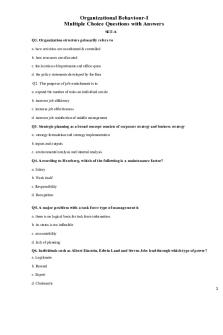
Organizational Behaviour MCQ SET
- 20 Pages
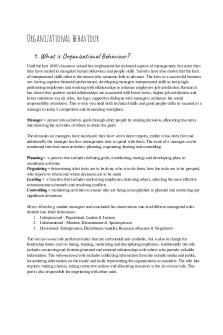
Organizational behaviour
- 67 Pages

Organizational Behaviour
- 2 Pages
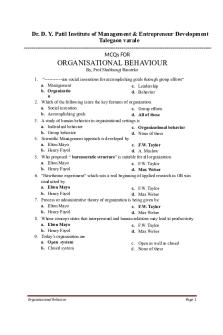
Organizational Behaviour mcqs
- 27 Pages
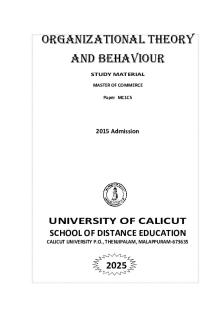
Organizational theory and behaviour
- 186 Pages
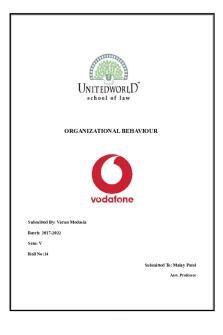
Organizational Behaviour Project
- 15 Pages

Chapter 2 ORGANIZATIONAL BEHAVIOUR
- 23 Pages

Organizational Behaviour Glossary
- 17 Pages

Organisational Behaviour MCQ
- 121 Pages
Popular Institutions
- Tinajero National High School - Annex
- Politeknik Caltex Riau
- Yokohama City University
- SGT University
- University of Al-Qadisiyah
- Divine Word College of Vigan
- Techniek College Rotterdam
- Universidade de Santiago
- Universiti Teknologi MARA Cawangan Johor Kampus Pasir Gudang
- Poltekkes Kemenkes Yogyakarta
- Baguio City National High School
- Colegio san marcos
- preparatoria uno
- Centro de Bachillerato Tecnológico Industrial y de Servicios No. 107
- Dalian Maritime University
- Quang Trung Secondary School
- Colegio Tecnológico en Informática
- Corporación Regional de Educación Superior
- Grupo CEDVA
- Dar Al Uloom University
- Centro de Estudios Preuniversitarios de la Universidad Nacional de Ingeniería
- 上智大学
- Aakash International School, Nuna Majara
- San Felipe Neri Catholic School
- Kang Chiao International School - New Taipei City
- Misamis Occidental National High School
- Institución Educativa Escuela Normal Juan Ladrilleros
- Kolehiyo ng Pantukan
- Batanes State College
- Instituto Continental
- Sekolah Menengah Kejuruan Kesehatan Kaltara (Tarakan)
- Colegio de La Inmaculada Concepcion - Cebu
